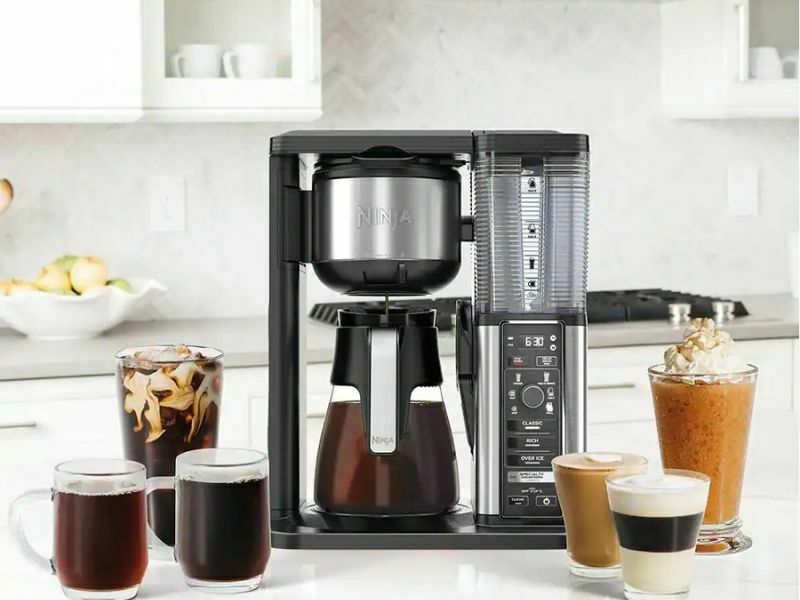Coffee maker maintenance is a crucial step to making delicious coffee, but some people don’t know how to clean it at home. Afraid of cleaning their own machine, they drain their bank account on pricey coffee at the store. You, on the other hand, are a thrifty lady with a passion for life’s pleasures. You don’t want to waste your hard-earned money on frivolous things like brewed coffee. So, please allow me the honor of explaining how easy it is to clean your coffee maker and what exactly you need to do to keep your machine running smoothly and efficiently.
What is a Coffee Maker?

Coffee Makers, also known as drip coffee makers, automatic coffee makers and electric coffee makers, are an essential part of the morning routines of millions of people. With the right coffee maker you can quickly brew a cup or even a whole pot of coffee that will wake you up in the morning and give you the energy to start your day.
There are many different types of coffee makers available. Coffee machines can be classified into one of three main categories: manual, semi-automatic and automatic. Manual coffee makers require you to time everything yourself and apply heat at just the right time for just the right amount of time. Semi-automatic machines give you more control over the brewing process but less control over other factors such as temperature and timing. Fully automatic machines take care of all aspects of brewing for you with just one press of a button.
Different types have different advantages but also different disadvantages. It’s important to know what kind of coffee machine is best for your needs before making a purchase so that you wind up with a machine that fits your lifestyle.
Why You Should Clean Your Coffee Maker
Maintaining a clean coffee maker will give you better tasting coffee, improve the lifespan of your machine and possibly make you healthier.
“Bacteria and mold can grow in the nooks and crannies of your coffee maker,” says Leslie Reichert, a green cleaning coach who blogs at The Green Cleaning Coach. “If you’re using a paper filter it may not be as bad, but if you have a permanent filter there are the areas where coffee grounds are trapped that never get washed out.”
There are so many reasons to clean your coffee maker:
- Sip on some great-tasting coffee: Coffee is an acquired taste — this we know — but it’s also an expensive one. So why not keep that java as good-tasting as possible? It’s easy to do when cleaning your coffee maker regularly.
- Get the most out of your machine: Your coffee maker is not cheap and by maintaining it, you’ll extend the life of your machine.
- Avoid bacteria and mold: Not only does bacteria and mold affect the taste of your brew, but if ingested, it can cause gastrointestinal issues…which certainly won’t make you feel any better in the morning. Maintaining a clean coffee maker will give you better-tasting coffee, improve the lifespan of your machine and possibly make you healthier.
“Bacteria and mold can grow in the nooks and crannies of your coffee maker,” says Leslie Reichert, a green cleaning coach who blogs at The Green Cleaning Coach. “If you’re using a paper filter it may not be as bad, but if you have a permanent filter there are the areas where coffee grounds are trapped that never get washed out.”
How Often to Clean a Coffee Maker
How often you clean your coffee maker depends on the type of coffee maker you have, your personal preference and what you’re willing to do to keep it from getting moldy.
Here are some general guidelines:
- Drip coffee makers should be cleaned once a month, at least. If you use your machine daily, then cleaning it weekly might be in order.
- French press coffee makers should be cleaned after each use, but if you don’t want to do that, at least clean it once a week.
- Keurig single-serve machines should be descaled once a week or once a month depending on how much you use the machine.
- If you have any doubts about whether your coffee maker needs cleaning, err on the side of caution and give it a quick scrub.
How to Clean Coffee Maker

Coffee makers are one of the most used kitchen appliances in our kitchens. Whether you use a single serve coffee maker or a large 10-cup coffee maker, you should clean your coffee maker regularly. Unclean machines can produce coffee that tastes bad and cause health issues if not cleaned properly.
Cleaning your coffee maker is easy, yet many people are afraid to do it. If you have this problem, then this article is for you. Here we will tell you a few steps to make it easier for you to clean your coffee maker.
Step 1: Cleaning the Basket
The basket should be cleaned regularly with soap and water after each use. You can also use baking soda as an alternative to soap and water because baking soda has an alkaline nature that can help neutralize odors.
Step 2: Cleaning the Filter Holder
The filter holder can be cleaned by soaking it in a mixture of vinegar and water for about 30 minutes. Then rinse with warm water until no more sap is visible.
Step 3: Cleaning Carafe
You can clean the carafe with a mixture of hot water and vinegar, then rinse with warm water until no more sap is visible. This cleaning method helps remove stains on glass carafes
Clean Coffee Maker With Water And Vinegar
Cleaning your coffee maker with water and vinegar is an easy task. Just follow these simple steps:
- Step 1: Fill the reservoir of your machine with equal parts white vinegar and water. The amount depends on the size of your machine so be sure to fill it accordingly.
- Step 2: Run the mixture through as you would normally make coffee. If you have a smaller coffee maker, just run it through once. For larger coffee makers, run it through twice to ensure that the entire machine gets cleaned out.
- Step 3: Take a damp cloth and wipe down all surfaces of your coffee maker including around the buttons and knobs on top of the machine.
- Step 4: Let sit for 5-10 minutes before rinsing with clear water completely. You want to be sure that there is no remaining vinegar left in your machine as this will affect the taste of your first pot of coffee after cleaning.
Clean Coffee Maker With Baking Soda
You just need to follow a few simple steps:
- Step 1: Remove any leftover grounds or filters from the machine.
- Step 2: Rinse everything with water to get rid of loose particles.
- Step 3: Run a brew cycle using white vinegar and water in place of coffee grounds and water (depending on the type of machine you have).
- Step 4: Rinse again to get rid of the vinegar smell and any leftover residue.
Your coffee maker should come with specific instructions for cleaning, but this process works for most machines, including Keurigs, French presses and percolators.
Clean coffee maker with lemon juice with water
Supplies needed:
- 1 lemon, cut in half
- Water
- Empty pot and washcloth or paper towel
Method:
- Fill reservoir with water and add 1 tablespoon of lemon juice for every cup of water. For example, if your pot holds 12 cups of water, use 12 tablespoons of lemon juice.
- Run the mixture through one cycle (without coffee).
- Pour out solution and run two more cycles with just plain water to remove any traces of lemon flavor from the machine. If your coffee maker has a cleaning cycle built-in, use it!
How To Maintain Your Coffee Machine For Longer
Here are some of top tips:
- Clean the grinder with hot water and detergent; wipe dry before reassembling
- Remove any buildup from heating element with vinegar solution or citric acid powder dissolved in water
- Rinse out filter basket thoroughly after each use to prevent clogging of mesh screen inside basket that can lead to bad tasting coffee or even worse, a damaged heating element!
- Wipe down exterior surfaces regularly using mild soap and warm water; rinse off with damp cloth then dry completely before storing away for next day’s use.
Conclusion
Cleaning one’s coffee maker will help keep the coffee tasting better and fresher, longer. This is especially true for those who consume large quantities of coffee daily. It will also help to remove mold and mildew from the machine, creating a healthier brew that tastes and smells better!





